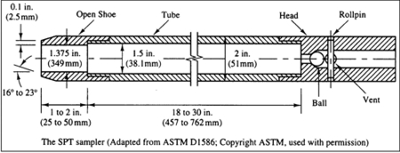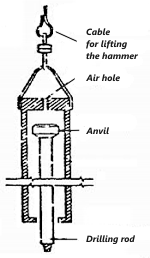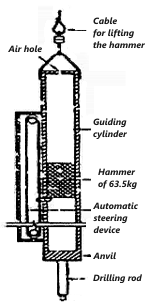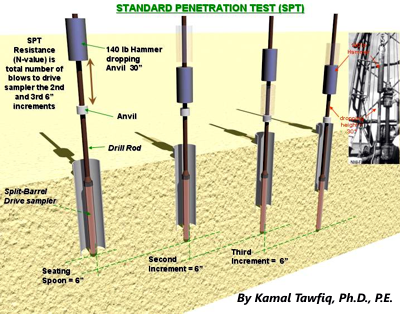Standard penetration test (SPT) is one of the most common in situ testing methods. SPT test is used to roughly estimate the strength of subsurface soils.
|
|
| (Source: http://www.vulcanhammer.net/geotechnical/laboratory_field.php) |
At the required depth, one hammer of 63.5kg falls freely from the distance of 76.0cm to drive a standard sampler (so-called split barrel sampler) into the ground below the bottom of borehole. The split barrel sampler is pushed into the ground in three 15cm intervals. The number of blows of each interval is recorded and the sum of blows of the second and the last intervals is a standard penetration resistance or N-value.

|
| Split barrel sampler |
|
|
| Split barrel sampler is driven in three rounds of 15cm per each |
The number of blows of the first round is for reference only because this round is applied to ensure the sampler is fully within the undisturbed zone. Therefore, if N1, N2, N3 are the number of blows for the first, second and the last round respectively then N=N2+N3.
So far the rate of blows has not been indicated in the standard but as the rule-of-thumb, the rate of 15-20 blows/minute is reasonable.
There are three types of hammer used in SPT test: donut, safety and automatic hammer.
One of the common issues in SPT test is the ratio of energy transfered from anvil to the sampler. The maximum and the minimum ratio are achieved with the automatic and donut hammer respectively (see table below).
| Donut hammer | Safety hammer | Automatic hammer | |
| Energy ratio | 45% | 60% | 100% |

|

|

|
|

|

|

|
Geotechnicians could roughly estimate the soil consistency based on SPT values as the following table:

|
| (Source: Soil Mechanics, T.W. Lambe và R.V. Whitman) |
More details about SPT test could be found in following links:
2) http://www.geocities.ws/dominic_trani/paper2.html#Introduction
3) http://www.geotechdata.info/geotest/standard-penetration-test













 Standard penetration test (SPT) is one of the most common in situ testing methods. SPT test is used to roughly estimate the strength of subsurface soils.
Standard penetration test (SPT) is one of the most common in situ testing methods. SPT test is used to roughly estimate the strength of subsurface soils.
